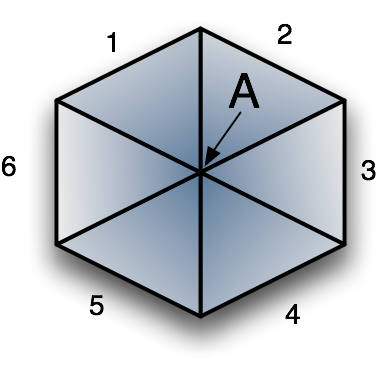Finding a nice, simple explanation of what vertex normals is, is not actually that easy. Which is a shame, because it's really not a difficult concept. A vertex normal is simply the average of the surface normals of all the polygons that a particular vertex is part of. Look at the following image:

That's not a cube, by the way, For simplicity, we're looking at a flat, two-dimensional mesh of six triangles. There are a total of seven vertices used to make the shape. That vertex marked A is shared by all six triangles, so the vertex normal for that vertex is the average of the surface normals for all seven triangles. Averaging is done per element, so the x values are averaged, the y values are averaged, and the z values are averaged, and the result, put into a new Vector3D is the average vector.
Let's look at how these were calculated in the Wavefront OBJ loader:
GL_FLAT and Surface Normals
If we're using GL_FLAT shading, the array of normals we need to build for the mesh pictured above will have six vectors in it, which means eighteen GLfloats. Each vector in that array needs to be the normalized surface normal for one triangle, and the normals need to be in the array in the same order that the triangles are passed into glDrawElements().
Here's how we can calculate the surface normal again (this is a slightly different algorithm than the one in my previous posting). The second function calculates the surface normal, but uses the first function.
static inline Vector3D
{
Vector3D ret;
ret.x = end.x - start.x;
ret.y = end.y - start.y;
ret.z = end.z - start.z;
vectorNormalize(&ret);
return ret;
}
static inline Vector3D
{
Vector3D u = Vector3DMakeWithStartAndEndPoints(triangle.v2, triangle.v1);
Vector3D v = Vector3DMakeWithStartAndEndPoints(triangle.v3, triangle.v1);
Vector3D ret;
ret.x = (u.y * v.z) - (u.z * v.y);
ret.y = (u.z * v.x) - (u.x * v.z);
ret.z = (u.x * v.y) - (u.y * v.x);
return ret;
}
So, to create the array of normals for GL_FLAT, we simply need to loop through the triangles (in the same order we'll later loop through them to draw them, and call Triangle3DCalculateSurfaceNormal(), storing the results in an array of GLfloats or Vector3D (remember, one Vector3D is the same as an array of three GLfloats.
GL_SMOOTH and Vertex Normals
Now, if we're using a shading model of GL_SMOOTH, however, we need to pass in a different normal array - an array of vertex normals. And this time, instead of passing an array that contains one normal for each triangle, we need to pass one normal for each vertex, in the same order that the vertices appear in the vertex array that we pass to OpenGL using GLVertexPointer(). For speed and simplicity, I calculate both surface and vertex normals in the same method in the Wavefront OBJ loader:
{The basic idea is that as we loop through the triangles, we keep track of how many times each vertex is used, and every time we use one, we add the surface normal of the triangle to the vertex array element corresponding to the vertex being used. When we're all done, we loop through the vertices, dividing vertex array, which has the sum of all the surface normals for all the triangles in which that vertex is used, and divide it by the number of triangles it's used in.
if
free(surfaceNormals);
// Calculate surface normals and keep running sum of vertex normals
surfaceNormals = calloc(numberOfFaces, sizeof(Vector3D));
vertexNormals = calloc(numberOfVertices, sizeof(Vector3D));
NSUInteger index = 0;
NSUInteger *facesUsedIn = calloc(numberOfVertices, sizeof(NSUInteger)); // Keeps track of how many triangles any given vertex is used in
for
{
OpenGLWaveFrontGroup *oneGroup = ;
for
{
Triangle3D triangle = Triangle3DMake(vertices, vertices, vertices);
surfaceNormals = Triangle3DCalculateSurfaceNormal(triangle);
vectorNormalize(&surfaceNormals);
vertexNormals = Vector3DAdd(surfaceNormals, vertexNormals);
vertexNormals = Vector3DAdd(surfaceNormals, vertexNormals);
vertexNormals = Vector3DAdd(surfaceNormals, vertexNormals);
facesUsedIn++;
facesUsedIn++;
facesUsedIn++;
index++;
}
}
// Loop through vertices again, dividing those that are used in multiple faces by the number of faces they are used in
for
{
if
{
vertexNormals.x /= facesUsedIn;
vertexNormals.y /= facesUsedIn;
vertexNormals.z /= facesUsedIn;
}
vectorNormalize(&vertexNormals);
}
free(facesUsedIn);
}
One thing that you might have noticed is that I used calloc() rather than malloc(). These two calls do pretty much the same thing, except that calloc initializes all elements to 0, which is important when you're doing running counts and adding values rather than setting values.
Now, on to texture mapping...








No comments:
Post a Comment